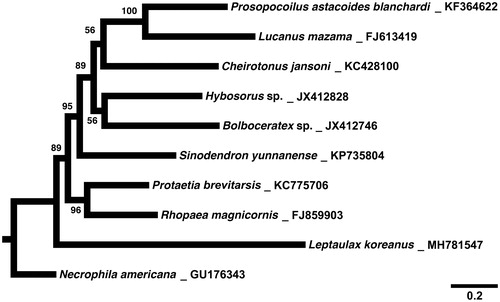Abstract
In the present paper, we make a first report on the complete mitochondrial DNA genome of Leptaulax koreanus, a Korean endemic species, in Passalidae. The mitogenome is 18,730 base pairs with 13 protein-coding genes, 22 tRNAs, 2 rRNAs, and a 4240 bp long AT-rich region. The overall base composition is 78.4% AT and 21.6% GC. The maximum likelihood analysis suggested that L. koreanus is a sister to other Scarabaeoidea species.
Passalidae consists of 680 species and 61 genera in two subfamilies worldwide (Reyes-Castillo Citation2002). They are mainly distributed from tropical regions to temperate regions in Australian, Nearctic, Oriental, and Ethiopian regions (Lawrence et al. Citation1999). Members of the family exhibit a form of sub-social behaviour that adults tend and feed their larvae, and all developmental stages can be found in galleries in decayed woods (Reyes-Castillo and Halffter Citation1984). Leptaulax koreanus was described by Nomura et al. (Citation1993). The species is an only species within the family that can be found in Korea while most species are distributed as mentioned above. The disjunctive distribution and relationship of the species within the family are still ambiguous and are yet to be answered. Up to date, no complete mitochondrial genome has been published within the genus Leptaulax and even the family. In the present study, we sequenced the complete mitochondrial genome of L. koreanus for a phylogenetic study to answer the questions above. A voucher specimen, collected from the Gwangneung forest in May 2017, is deposited in the Korea National Arboretum, Pocheon, South Korea.
The complete mitochondrial genome of L. koreanus was sequenced using Illumina MiSeq. A total of 20,345,314 reads were analysed to generate 2,714,580,212 base pairs of sequence and assembled in Geneious 10.2.2 (Kearse et al. Citation2012). Secondary structure prediction of tRNAs except for tRNAAsn and tRNASer was annotated with the improved Mitochondrial Genome annotation (MITOS) webserver (Bernt et al. Citation2013, http://mitos.bioinf.uni-leipzig.de/) and the secondary structures of tRNA genes were analyzed by comparison with the nucleotide sequences of other insect tRNA sequences.
The complete mitogenome of Leptaulax koreanus is 18,730 bp in length, consisting of 13 protein-coding genes (PCGs), 22 tRNAs, 2 ribosomal RNAs, and a major non-coding 4240 bp (A + T rich region) and is registered in GenBank (accession number MH781547). The overall base composition is A (36.4%), C (14.7%), T (6.9%), and G (40.0%), and A + T content (78.4%) is slightly higher than that of other Scarabaeoidea species (75.6% in Rhopaea magnicornis, 75.1% in Sinodendron yunnanense, 74.7% in Necrophila americana, 74.5% in Protaetia brevitarsis, and 67.0% in Prospocolius astacoides). All of the PCGs started with typical ATN codon as the start codon except for NAD5, which started with AAT: six (COII, ATP8, NAD3, NAD4L, CYTB, NAD1) start with ATT, three (NAD2, NAD4, NAD6I) with ATA, and three (COI, ATP6, COIII) with ATG. In addition, 12 of 13 PCGs harbour the typical stop codon TAA, whereas NAD4 terminated with an incomplete stop codon. The A + T rich region of the full-length 4,240 bp is located between 12S rRNA and tRNAIle genes. The A + T content of this region contains 81.8%, which is higher than that of other Scarabaeoidea species (81.6% in S. yunnanense, 79.0% in N. americana, 78.2% in R. magnicornis, 72.6% in P. astacoides, and 65.3% in Pr. brevitarsis).
A phylogenetic position of L. koreanus was inferred, and the phylogeny suggested that L. koreanus is the basal group of Scarabaeoidea ().
Figure 1. A maximum-likelihood tree of 9 Scarabaeoidea species inferred from the nucleotide sequences of 13 PCGs in the mitochondrial genome. The numbers beside the nodes are percentages of 1000 bootstrap values. Necrophila americana in Staphylinoidea was used as an outgroup. Alphanumeric terms indicate the GenBank accession numbers.

Nucleotide sequence accession number
The complete mitochondrial genome sequence of Leptaulax koreanus has been assigned GenBank accession number MH781547.
Disclosure statement
The authors report no conflicts of interest. The authors alone are responsible for the content and writing of the paper.
Additional information
Funding
References
- Bernt M, Donath A, Jühling F, Externbrink F, Florentz C, Fritzsch G, Pütz J, Middendorf M, Stadler PF. 2013. MITOS: improved de novo metazoan mitochondrial genome annotation. Mol Phylogenet Evol. 69:313–319.
- Kearse M, Moir R, Wilson A, Stones-Havas S, Cheung M, Sturrock S, Buxton S, Cooper A, Markowitz S, Duran C, et al. 2012. Geneious Basic: an integrated and extendable desk to software platform for the organization and analysis of sequence data. Bioinformatics. 28:1647–1649.
- Lawrence JF, Hastings AM, Dallwitz MJ, Paine TA, Zurcher EJ. 1999. Beetles of the World: a key and information system for families and subfamilies [CD-ROM]. Version 1.0 for MS-Windows. Melbourne: CSIRO Publishing.
- Nomura S, Kon M, Johki Y. 1993. Description of a new species of Leptaulax (Coleoptera, Passalidae) from South Korea. Esakia. 33:51–57.
- Reyes-Castillo P. 2002. Passalidae. In: Bousquets JL, Morrone JJ, editors. Biodiversity, taxonomía y biogeografía de artrópodos de México: hacia una síntesis de su conocimiento. Vol. 3. Universidad Nacional Autónoma de México; p. 467–483.
- Reyes-Castillo P, Halffter G. 1984. La estructura social de los Passalidae (Coleoptera: Lamellicornia). Folia Entomol Mex. 61:49–72.
